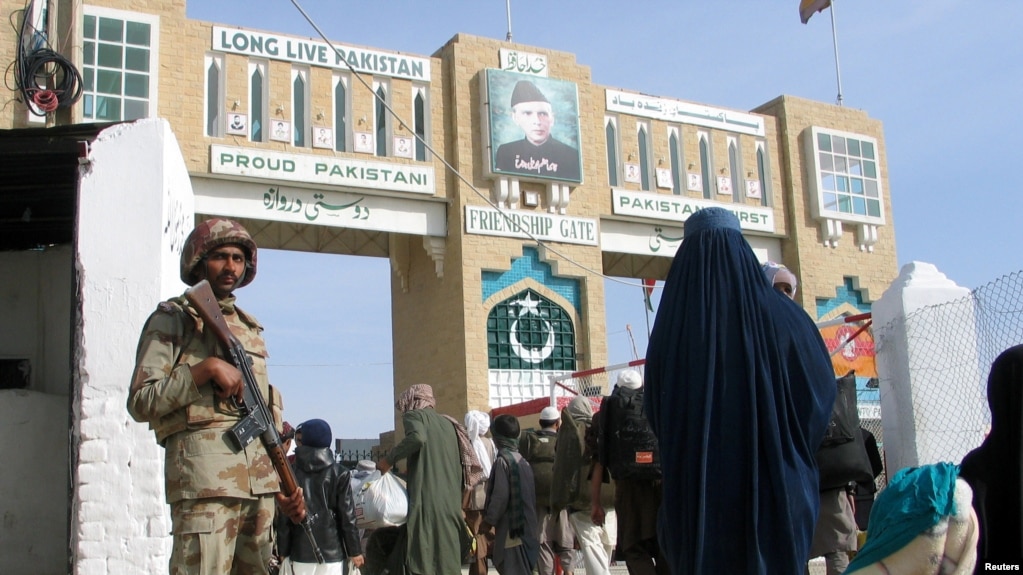
A Pakistani soldier keeps guard at the Friendship Gate, which marks the Afghan border crossing at the Pakistani town of Chaman.
by Zafar Iqbal Yousafzai 28 June 2023
The trade relationship between Pakistan and Afghanistan is of utmost importance. Trade is a crucial component of the two nations’ bilateral relations due to their proximity and shared history. At the same time, effective border-crossing locations are essential for facilitating trade and fostering economic cooperation.
Crossing points act as entry points for the transportation of products, facilitating trade between the two nations’ traders. These points of entry are essential for the movement of products because they give traders on both sides easy access, which promotes trade growth. They connect producers, suppliers, and consumers as key links in the supply chain.
Moreover, effective and well-run crossing points increase trade volumes and support economic expansion. They shorten transit times, lessen administrative roadblocks, and enhance the overall trade experience. Crossing points encourage trade efficiency, which is advantageous to both firms and consumers, by reducing customs procedures and ensuring a seamless flow of goods.
At the Chaman Pak-Afghan border in Quetta, a new crossing gate for transit trade was opened last month, signaling a significant advancement in the facilitation of commercial communities between Pakistan and Afghanistan. Together with the assistance of the governments of both nations, the chambers of trade and industry of Chaman and Spin Boldak established this new facility.
The inaugural event, which was well-attended by corporate executives, traders, and Pakistan Customs authorities, underscored the significance of this new crossing point. On the Pakistani side, the gate was opened by Haji Jalaat Khan of the Chaman Chamber of Commerce and Industry, and on the Afghan side, it was opened by Haji Sadiqullah of the Spin Boldak Chamber of Commerce and Industry.
The only town along the Afghan border with a distinct official crossing point set aside for trucks transporting products for transit is Chaman. In response to the increasing number of vehicles involved in the transit commerce between Pakistan and Afghanistan, a second crossing gate was established. The new gate is anticipated to speed up customs clearance and decrease the time needed for the process.
The new gate in Chaman is about a kilometer away from the Friendship Gate and provides a separate crossing area for Afghan and Pakistani women. Women on both sides of the border can travel safely and conveniently at this crossing point because it is only intended for families.
The current Friendship Gate will continue to be used for pedestrian traffic crossing as well as for customary trade between Pakistan and Afghanistan. By easing transit trade processes and creating stronger economic relations, the new crossing gate will improve the amenities accessible to both nations’ business communities.
The commercial sectors of Pakistan and Afghanistan have reacted favorably to the opening of the new crossing gate. They think it will be crucial in encouraging more seamless transit trade between the two countries. This change is anticipated to improve efficiency, lower administrative barriers, and expand prospects for cooperation and economic progress.
An important step in boosting bilateral trade between Pakistan and Afghanistan is the improved trade facilitation procedures at the Chaman border. Fostering strong trade relationships is essential for economic growth and regional stability as adjacent countries with common cultural and historical ties. The brand-new crossing gate represents the dedication to fostering bilateral trade and prosperity.
The establishment of this new border crossing is evidence of the ongoing efforts undertaken to eliminate obstacles and foster an atmosphere that is conducive for trade by both governments and the business community. The new gate at the Chaman border signifies an important development in economic relations between Pakistan and Afghanistan by facilitating more efficient transit commerce operations and providing more facilities for women. It is envisaged that this endeavor will boost both nations’ economies and open the door to more sectoral cooperation, which will be advantageous to the business communities and populations on both sides of the border.
